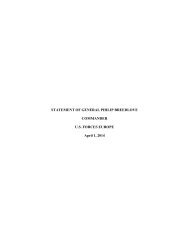FULLTEXT01
FULLTEXT01
FULLTEXT01
You also want an ePaper? Increase the reach of your titles
YUMPU automatically turns print PDFs into web optimized ePapers that Google loves.
TACTICAL THOUGHT<br />
2014 September 29 th<br />
1.7 Demarcations<br />
Tactics as an area of War Studies is strongly connected to operational art and strategy,<br />
particularly from the perspective of command levels. 62 A connection exists from a<br />
purely rational and practical sense; one has to have the tools and methods suitable for<br />
certain tasks so as to fulfil strategic goals at hand. In turn; they need to be organized by<br />
operational art over the whole operational area.<br />
However, the study does strictly focus on tactical thought and preference, involving<br />
operational art and strategy first in the discussion part of the study. The motive for the<br />
focus on tactics is the limited research in this area. The current view of declining<br />
knowledge and coherent understanding of tactics in the Swedish Armed Forces<br />
contributes to making this area particularly interesting to investigate.<br />
A scientific result of the character of tactical thought is regarded as yet another missing<br />
dimension, important to include in the more frequent discussions and critiques regarding<br />
strategy. Operational art is seen as a highly interesting and challenging area in Irregular<br />
Warfare, different from within a Regular Warfare context, not least for the absence of<br />
mechanized warfare. Certain aspects of operational art are highlighted in the discussion<br />
part; nevertheless, such focused research is regarded necessary for dealing with this vast<br />
area. The focus for investigating tactical thought has been on articulations of tactics<br />
from land force and amphibious force field unit commanding officers. These officers<br />
are argued to be the very ones that most profoundly have to understand and deal with<br />
military theory, parallel with the ability to command units in the most practical way,<br />
when choosing tactical concepts in different conflict contexts. They are therefore<br />
viewed as representing the unity of military theory and practice in the military trade<br />
craft. Command levels below company command are argued to deal less with theory,<br />
whereas levels above battalion command are argued to deal less with practice,<br />
according to my experience.<br />
A demarcation regarding the historical framing has been made with a start from the<br />
early part of 1800. The motive has been that Clausewitz is commonly understood and<br />
recognized as an icon of the start of relatively modern thought and philosophy on war<br />
and warfare. Irregular Warfare, seen as a particular form of warfare to be used in<br />
combination with one’s own regular troops, or as an Insurgency or Counterinsurgency<br />
method, can however be argued to have been an extensive area of modern military<br />
thought and practice already during the 17 th and 18 th century. 63<br />
62 Michael James Brennan and Justine Kelly, Alien – How Operational Art devoured Strategy (Carlisle<br />
PA: Strategic Studies Institute, US Army War College, 2009). The authors present a sharp critique on<br />
how Operational Art, which they argue is wrongly interpolated from military theory, has been developed<br />
since 1982 diverging and splitting strategy from tactics.<br />
63 Johan Ewald, Treatise on Partisan Warfare, transl. and annot. Robert Selig and David Curtis Skaggs,<br />
(Westport CT: Greenwood Press, 1991), Introductory Essay, p. 14. In 1692, the French introduced the<br />
first experiences of light troops drawn from Eastern Europe, p. 12; a first account of this form of modern<br />
Irregular Warfare tactics is addressed to Antoine de Villes, Memoires sur la Guerre from 1711.<br />
19





